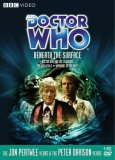| Reviews & Columns |
|
Reviews DVD TV on DVD Blu-ray 4K UHD International DVDs In Theaters Reviews by Studio Video Games Features Collector Series DVDs Easter Egg Database Interviews DVD Talk Radio Feature Articles Columns Anime Talk DVD Savant Horror DVDs The M.O.D. Squad Art House HD Talk Silent DVD
|
DVD Talk Forum |
|
|
| Resources |
|
DVD Price Search Customer Service #'s RCE Info Links |
|
Columns
|
|
|
Doctor Who - Beneath The Surface
Since most of my favorite films are already on DVD, the thing I've found myself looking forward to the most now are the new Doctor Who disc. With a restored image, great extras and some really fun stories, these releases are quality discs that not only present the shows in a good light, but also include bonus materials that look behind the scenes. The latest such offering is a three adventure set entitles Beneath the Surface. The set consists of three Who stories (also available separately), Doctor Who and the Silurians, The Sea Devils, and Warriors of the Deep that all involve the same prehistoric race who once ruled the world. A nice themed set, the first two adventures are great, classic adventures, and while the third serial is only so-so, mated with the other two this set is hard to resist.
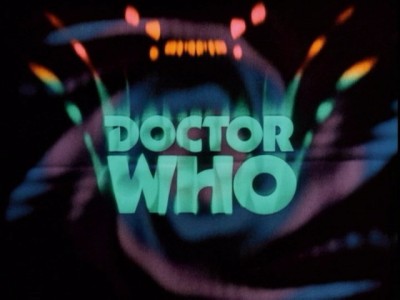
Background:
Okay, most of you probably already know this, but for those who aren't familiar with the long running SF show, here's a bit of history. Doctor Who started in 1963 with William Hartnell creating the role of The Doctor, a mysterious and crotchety old man who traveled through time and space with his granddaughter Susan, and two of her teachers. They traveled in the TARDIS, a device that looked like a small London Police Call Box on the outside, but on the inside was an immense and spacious time machine.
The show was a hit but in 1966 there was a problem. Hartnell became ill and had to leave the show (though some say it was the new production team rather than illness that caused the departure.) In order to keep the show going the producers and writers came up with an ingenious idea: Since there wasn't much known about the Doctor (aside from the fact that he was an alien) why not have him die and then regenerate his entire body in the form of a new actor. This turned out to be not only a good gimmick to keep the show going, but also made the main character more interesting and mysterious. As the show went on, more details of exactly who and what the Doctor was slowly emerged. It turned out that he was a 700+ year old Time Lord (or over 1000 depending on which Doctor you're talking to) from the planet Gallifrey who stole the TARDIS from a repair bay, which explains why it doesn't always work as well as it should, and was on the lam. He did this because he didn't see eye-to-eye with the rest of his race. He much preferred to get involved and help people out when he could rather than just sit back and watch things happen like the rest of the Time Lords.
As the years went on the show continued to be popular and the BBC went through several actors playing the Doctor and even more traveling companions. This set features two different Doctors; Jon Pertwee and Peter Davison.
Doctor Who and the Silurians (Story 59):
This was Pertwee's 2nd story and is a departure from much of what had gone on before. Through the first two incarnations of the Doctor, the program had been aimed at children, but now the BBC was reaching out for a more adult audience. The idea was to make the show more like the Quatermass serials of the 50's. To accomplish this they made several changes in the show, the most drastic being that the Doctor would no longer travel through time and space. (This was only temporary however.) He was based on Earth now and is employed as the scientific advisor to UNIT, the United Nations Intelligence Taskforce, a peacekeeping organization that handles the bizarre and unusual, like alien invasions. Gone were his juvenile companions too. Instead of having kids tagging along with him (originally intended as a character that children could relate to) his companions were older now, adults who could help The Doctor instead of just tagging along.
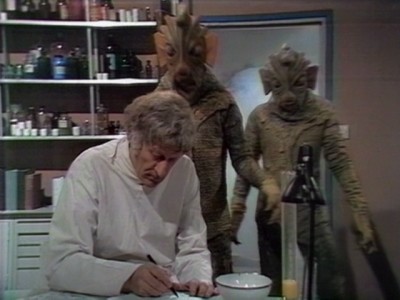
In this second of the Earth-bound serials The Doctor has come to grips with the fact that he can no longer travel the cosmos. In fact this is one of the few Doctor Who stories where the Tardis is neither seen nor mentioned.
As the story opens The Doctor is tinkering with Bessie, an antique car (actually a kit-car) that was given to him for helping foil the Auton invasion in the previous story (Spearhead from Space. This is Bessie's first appearance and the bright yellow car would be a fixture in the show during this period.)
Summoned by UNIT's British commander, Brigadier Alistair Gordon Lethbridge-Stewart, to a secret research center, he initially baulks at going. Eventually Dr Elizabeth Shaw (Caroline John), a scientist also working for UNIT, convinces him and off they go. The center that they're investigating is trying to perfect a method of generating clean, safe, and cheap nuclear energy. The problem is that whenever the reactor is activated, it experiences a sharp power loss that no one can explain. There was also a strange accident that befell a pair of scientists at the center. While exploring the caves the run under and around the reactor, they were attacked by something. One man was killed and the other driven mad.
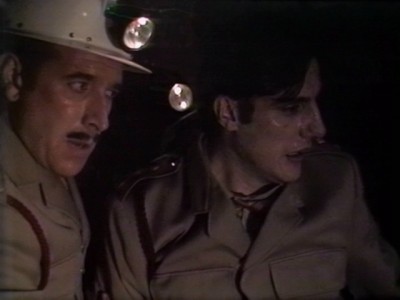
As the Doctor and Liz investigate, they discover that the power is being siphoned off by the Silurians, an intelligent race that used to rule the Earth. Millions of years ago, their scientists predicted that a huge asteroid would crash into the planet leaving it uninhabitable for years. Instead of perishing, the Silurians created hibernation chambers and the entire race went to sleep. The only problems are that the disaster never happened and the automatic system that was to awaken the race failed. They stayed in suspended animation until the work at the nuclear reactor awakened a few of them. Now they are using the reactor's power to awaken the rest of their race, and when that happens they will emerge and take their rightful place as rulers of Earth.
This was a really good serial. Running seven episodes it is a bit long, and there are some sections that are a bit slow, but Pertwee's Doctor really comes to life in this adventure. In the preceding story he was unconscious half of the time, fatigued from his forced transformation, and when he awoke there wasn't enough time to really get to 'know' his character. In this adventure his character comes to life. Elegantly dressed and not suffering fools gladly, Pertwee's Doctor is the champion of reason over emotion, and this serial shows that off very well. Though the head of the research lab is only worried about his career, and will do anything to keep the experiments going no matter what the cost, the Brigadier the xenophobia of a military man and only wants to kill the unfamiliar creatures, but it's the Doctor who sees the profit in reasoning with them. After all there is much that both races can learn from each other and the planet is big enough for both to inhabit peacefully.
This serial is also markedly more mature than earlier stories. With a grim feeling and a more realistic story, this adventure packs quite a punch. There are shades of gray and different points of view are examined. The Brigadier wants to destroy the Silurians, which isn't such a radical position since they do attack and capture and kill a number of people. The Silurians aren't totally evil either, they want their race to awaken and, at least some of them, are willing to cooperate with humans. Even the young Silurian, the serial's main villain, acts in an understandable way when he learns that human soldiers are searching the tunnels.
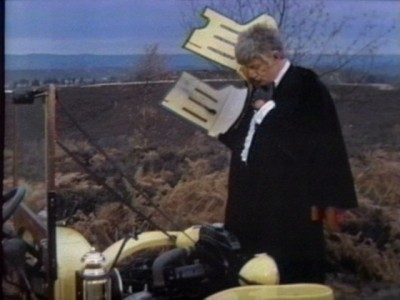
Of course the main aim of the show is to entertain and this one does that well. There are dinosaurs, creepy monsters, even creepier scientists and politicians, and some suspenseful segments. The Doctor has some good lines and his intelligence shines through, as does his infectious personality. The only weak part in the series is the interaction between Pertwee and Caroline John. They don't have a lot of chemistry on-screen and some of it may have been personal. Pertwee mentioned, at a public appearance I attended over 20 years ago, that he and Jon never got along and that he wasn't upset to see her leave. Whatever the case, in this series Jon is still trying to find her character's place in the show and comes across as a bit stiff at times.
The other characters don't have that problem. Even some of the more minor supporting characters are well developed and populated with some strong actors including Paul Darrow who would later shine years later as the antagonist in Blake's Seven.
The Sea Devils (Story 62):
Still stranded on Earth, but with a new companion, Jo Grant (Katy Manning), The Doctor (Jon Pertwee) once again encounters a menace from the Earth's distant past. This time it is an aquatic species of Silurians: the Sea Devils.
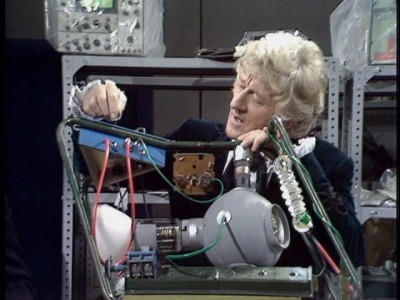
With the Master (Roger Delgado), the Doctor's mortal enemy, behind bars at last the Time Lord travels to the island prison where he's being held. While visiting The Doctor discovers that some ships have been mysteriously disappearing in the area and decides to investigate. It turns out that The Master have awoken some of the Sea Devils and is conspiring with them to retake the Earth. Once again The Doctor tries to reason with them and to co-exist with humans, but with the Master goading on the prehistoric amphibians (not to mention revealing what happened the last time The Doctor tried to help their cousins) a full scale invasion is planned.
This was a very good story, and includes one of the iconic images from the series, that of a group of Sea Devils walking out of the sea. It was written by Malcolm Hulke, the same scribe who penned Doctor Who and the Silurians, so he had a firm grasp on both the creatures and The Doctor, and crafted an engaging six-episode tale. The serial does feel a little padded though, with the Doctor and/or Jo being captured and escaping frequently. If it had been cut down to a four or even five episode adventure it would have played out much better.
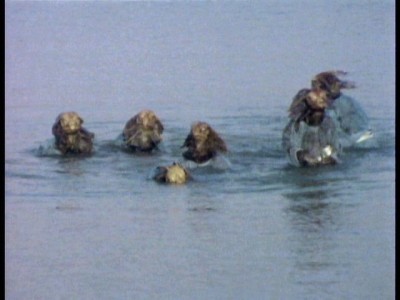
Like the Silurians, the Sea Devils are sympathetic creatures, though this time they appear to be far more aggressive. There's more than just three, so it makes the invasion, when it finally arrives, a bit more believable. Their weapons make a little more sense too. Hand-held force beams are easier to swallow than the third-eye laser that the Silurians sport. (Exactly where in nature do lasers occur naturally??) Their design was creepy and not nearly as silly as they would appear in the last story in this set (more on that later) which makes them great Who villains.
The other villain of this story is the Master, magnificently play by Roger Delgado. His almost regal temperament mixed with a mercurial personality make him both menacing and powerful. This story has some of the best interactions between the Doctor and his adversary too. The sword fight in the prison halls is fun, but their banter throughout the whole serial is really well scripted. Both funny and dramatic, it gives these Earth-bound stories a grander scale, knowing that the Doctor is facing someone that is mentally his equal.
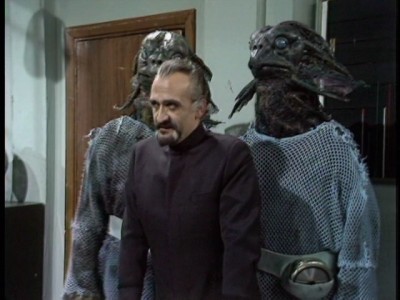
One flaw in this serial that has to be noted is the incidental music. The score was made almost entirely with synthesizers, which sounded grating and tinny. Instead of building up the drama, the background score only serves to remind viewers that they're watching a TV show. One with an irritating score.
Warriors of the Deep (Story 131):
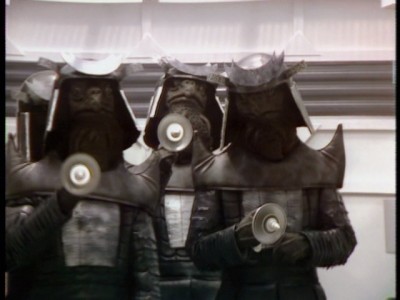
We skip ahead nearly a dozen years for the next story, where the Silurians and Sea Devils team up and hatch a plot to retake their planet. This time The Doctor is Peter Davison, and he Tegan (Janet Fielding), and Turlough (Mark Strickson) make an emergency landing in the Tardis on a sea base.
Set in the future, the Earth has two major powers that are in the midst of a cold war that could turn hot at any moment. The sea base is a hidden arsenal of missiles that are ready to launch at the enemy as soon as they make a move. Finding the three time travelers in the secret base, the commander assumes they are spies, and his conviction grows even stronger when a mysterious sub appears on their screens, a ship that is impenetrable to all of the bases weapons.
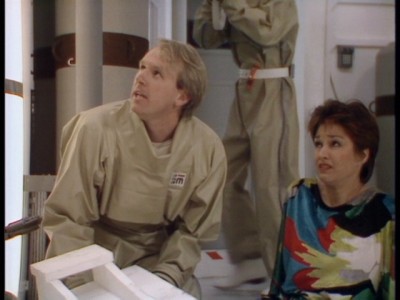
The submarine is actually a Silurian Battle Cruiser. The ancient reptiles have awoken once again, and this time they've managed to un-freeze a squadron of Sea Devil Warriors. They plan to storm the sea base, fire the missiles, and then sit back and watch as humanity destroy itself with an apocalyptic war. The only thing stopping them is The Doctor, who once more has to convince a suspicious official that he's not a spy.
This was the season opening show for Davison's last year as the Doctor, and the BBC wanted to kick it off with a bang. On paper it must have sounded great; bringing back two classic villains from the 70's and having them team up in a story that was a metaphor for the then-current Cold War. Unfortunately, the execution was less the perfect. Far less than perfect. With the schedule tight because of an unexpected election called by Margaret Thatcher, the story had to be rushed and it shows. The lighting on the sets is bright and harsh. As where the first Silurian story had them hiding in dimly-lit underground caverns filled with shadows, this time the costumes were shown in full light and didn't look nearly as menacing. The reptilian villains were often shown with their neck flaps, which were supposed to be tucked under the collars of the torso section of the costume, sticking out rather blatantly. Didn't ANYONE on the set spot that?
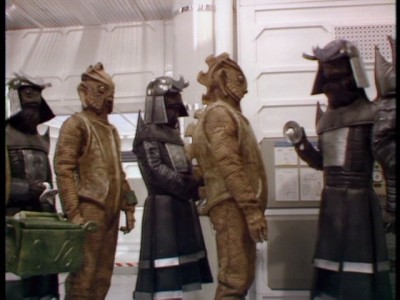
Maybe they did and they just didn't have time to reshoot. The schedule was so tight that in one scene an actor falls on a dead monster that had just been painted. Paint appears on his sleeve, but as another shirt wasn't available and there was no time to get one, he just has to hide it for the rest of his scenes.
The undersea diving outfits the human soldiers wear are ridiculous, basically a loose tan jumpsuit with a plastic cookie-jar for a head piece, but they look like an Edith Head masterpiece compared to the Myrka. The Sea Devils send a monster into the sea base to lessen the resistance and it is one of the worst Doctor Who monsters ever. And that's saying a lot. Basically a giant green pantomime horse, it moves slowly, ever so slowly, through the base. It couldn't open it's mouth, it didn't have fearsome claws, and apparently possessed no offensive capabilities at all, the creators decided to have it electrocute people. In one case a soldier runs up to the huge monster, gun in hand, and screams as he's electrocuted. It was hard not to laugh. The harsh lighting doesn't make it any better.
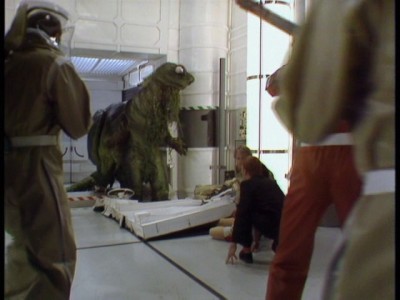
The story isn't very original either. The sea base is easily interchangeable with a space station, and The Doctor finds himself in very familiar territory when he's accused of being a spy. There's also a few nonsensical moments (at the end of the first episode when The Doctor falls With very bad costumes (don't get me started on the Samurai Sea Devils), horrible lighting, absolutely hilarious battle sequences and average direction, this isn't the worst episode of Doctor Who, but it's certainly no where near the best.
The DVD:
Audio:
All three stories come with their original mono soundtracks which sound fine. While none of the shows have much in the way of bass, their range is passable. There are a few sections in the first series where the dialog is just a little muddled, but it was undoubtedly recorded that way.
Video:
The restoration team has tired to work their magic with this set, with mixed results. While the images on these DVDs are certainly an improvement over their unrestored VHS counterparts, the early color (or should I say colour) episodes are not as clear and pristine as some of the B&W episodes from earlier stories.
Doctor Who and the Silurians was a very early color show for the BBC. They had only started broadcasting in color a month before. What's even more damaging is that the original color recordings no longer exist. For this disc the Restoration Team took the existing B&W recording of the show (16mm camera negatives of the broadcast itself), and added the color track from an off-the-air Betamax recording. Missing sections from the Beta master were then colorized to match the rest of the show. The results are good, but not great. The show has a greenish tint to the underground scenes and the colors are not as tight as they should be. The image is a little on the soft side, with the lines not being quite as tight as they should be. Having said that the full screen image is pleasing. The contrast is fine and it level of detail is good.
The Sea Devils looks better, especially the first three episodes. The colors are a bit tighter, and while they are a bit muted it doesn't look unnatural, just a bit old. The lines in this story were stronger, as was the level of detail. There was some noise in places, but overall this was a solid looking show.
The final story looked the best, which isn't too surprising since it was the most recent and there were good color tapes (1" transmission masters) of the show to work with. This story had less noise than the others and the colors looked the most vivid and bright. The image is bright (actually too bright) and the level of detail is great.
Extras:
This set comes with some informative and entertaining bonus features. Each episode comes with an optional pop-up trivia track and they're all very good. While some of the information isn't that interesting (like the date some scenes were filmed) most of it is well worth watching. They relate behind-the-scenes anecdotes, the history and filmographies of supporting characters, and changes in the story from the original shooting script. Though I prefer to watch the episodes once through without the trivia track since it can be a bit distracting from the show, it's a great reason to spin the DVD a second time.
There are also a nice set of commentary tracks. Silurians has a commentary with director Timothy Combe, producer Barry Letts, script editor Terrance Dicks, actors Caroline John, Peter Miles, Geoffrey Palmer and Nicholas Courtney on all episodes. On Sea Devils fans get to hear the thoughts of director Michael Briant, producer Barry Letts and script editor Terrance Dicks, moderated by late-eighties script editor Andrew Cartmel, and the Warriors track features actors Peter Davison and Janet Fielding, script editor Eric Saward and visual effects designer Mat Irvine. While I listened to bits of all of them (and would have listened to them all but I wanted to get this review up before DVDs become obsolete) my favorite were the commentaries to the final adventure. Peter Davison is relaxed as is Janet Fielding and they all have a good time ragging on the mistakes and goof and inconsistencies in the story. Well worth listening to.
Doctor Who and the Silurians also has Going Underground (19 min), a look at the filming of the subterranean scenes, Now and Then (10 min), a tour of some of the exterior locations used in the story and how they look today, and Musical Scales (14 min), a discussion of the music used in the show. Color Silurian Overlay (5 min) - is a featurette that explains how this series was restored and looks at some of the problems involved.
Sea Devils features some great featruettes too. First off is Hello Sailor! (37 min) - that discusses the trials and tribulations faced during the making of the show and focuses on the use of the British Navy and how they became involved. There's also an 8mm Film (4 min), a home movie of the production shot by one of the sailors who was an extra. This has a commentary from director Michael Briant, producer Barry Letts and script editor Terrance Dicks.
The final story in this set, Warriors of the Deep, also has The Depths (32 min) where the cast and crew recall the short production schedule and some of the (many) problems that were encountered. They Came from Beneath the Sea (13 min) a look at the monsters in the show, including some revealing interviews with the two men who played the Myrka. Science in Action (6 min) a clip from a 1987 program where visual effects designer Mat Irvine was interviewed about the special effects and models used for this story.
Each story also has a photo gallery, an isolated music track, and a .pdf file with the Radio Times listing for each episode.
Final Thoughts:
While the last story wasn't great, it's worth owning for the it's-so-bad-it's-good aspect and for the great commentary track. The other two adventures are classic stories featuring one of the best Doctors in the first run of the show and some great villains. With a wealth of extra material and a nicely restored image, these shows are a must-buy for Who fans. Highly Recommended. Casual fans who only want to get the very best stories should run out and buy the stand along version of Doctor Who and the Silurians.
|
| Popular Reviews |
| Sponsored Links |
|
|
| Sponsored Links |
|
|
| Release List | Reviews | Shop | Newsletter | Forum | DVD Giveaways | Blu-Ray | Advertise |
|
Copyright 2024 DVDTalk.com All Rights Reserved. Legal Info, Privacy Policy, Terms of Use,
Manage Preferences,
Your Privacy Choices | |||||||









